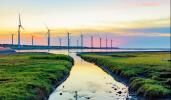21 December 2018
Perhaps more than any other country in the world, the Netherlands is about to see a huge ramping up of wind energy in the next few years, particularly offshore, bringing plenty of career opportunities throughout the supply chain.
Hans Timmers, Chairman of The Netherlands Wind Energy Association (NWEA), comments: “The Netherlands is blessed with a lot of wind, a lot of sea and with a roadmap devised by the government concerning the development of offshore wind.”
Hans admits that the Netherlands does have some catching up to do when it comes to European renewables targets. Currently, the Netherlands is ranked close to the bottom regarding European onshore wind energy production. For offshore wind however, it is in fourth place, only behind the UK, Germany and Denmark.
International supply chain
Describing himself as a change manager, Hans explains that one reason NWEA hired him is to help strengthen the visibility of the sector - to improve the position of wind energy. Whereas the NWEA members typically used to be farmers with a few turbines, the sector organisation now acts on behalf of the whole supply chain, including international operating companies. NWEA represents about 300 members and has industry giants such as Shell, Siemens and NUON/Vattenfall on the board.
The new impetus in the wind energy sector is tangible. The Netherlands is working hard to achieve the goals of the Energy Agreement, which means 4,450 MW of new offshore wind capacity has to be in place by 2023. To realise this an annual concession tender of around 700 MW is planned for the coming years.
This spring the Dutch government announced the Offshore Wind Roadmap 2030 outlining the next goals for offshore wind production. This roadmap ensures 1 GW will be annually tendered directly after the Energy Agreement, resulting in an additional 7 GW of offshore wind being realised before 2030.
On top of this, the government is negotiating a Climate Agreement. On July 10th the preliminary headlines have been presented and these look positive for Dutch offshore wind, Hans says. “The Climate Agreement will be the base for the future roadmap. According to the current planning by the end of the year the Climate Agreement should be signed and we will have certainty about the offshore wind targets on top of the already auctioned 4.5 GW, and the additionally planned 7 GW of the Roadmap 2030.”
7 GW by 2030
He explains that it is likely to be another 7 GW coming up to 2030. “This means annual tenders of an additional 1,000 MW between 2020-2027. Combined with the Roadmap 2030 that amounts to 2 GW of offshore wind tenders per year! This would set the Netherlands on course for the COP21 Paris Climate Agreement and create 18.5 GW of installed offshore wind by 2030!” Hans stresses that the PBL Netherlands Environmental Assessment Agency is projecting that the Netherlands can have more than 60 GW of offshore wind energy in the Dutch North Sea.
“Although we are saving energy by electrifying previous fossil processes, economic growth is expected to offset this so at the end of the day more gigawatts will be required. We are just at the beginning today with installed capacity of around 1000 MW offshore and 3.5 GW onshore.”
This means that currently there is way more onshore wind installed than offshore. Even though the Netherlands is a densely populated country, onshore wind energy production is expected to grow quite a bit, reaching 6000 MW- 6800 MW by 2022 and it might even double towards 2030, he points out.
Employment opportunities
This surge in wind energy capacity also leads to a surge in demand for qualified personnel. This has significant implications for employment opportunities and educational/training requirements. Atlas Professionals can play an important role in facilitating this, Hans adds.
“I think Atlas can help change the image of the sector. People need to understand the energy transition. Atlas can help raise awareness of the work it requires and people start appreciating the job and career opportunities the sector provides. We need more people in all aspects of the industry and more people choosing technical careers.”
Hans is optimistic things are starting to change. He feels the industry is gaining a buzz. He points to Delft University of Technology, which has 3,500 students directly and indirectly involved in wind energy and a staggering two million all over world. “We need highly educated people and a lot of craftsman - the technicians constructing, operating and maintaining the turbines.”
Transferring O&G staff to renewables
Atlas can also support oil and gas staff facing unemployment to switch and be re-educated into the renewables sector. “Those people know the offshore environment. Helping these people transfer could be an interesting business for Atlas.”
.png)
.png)


